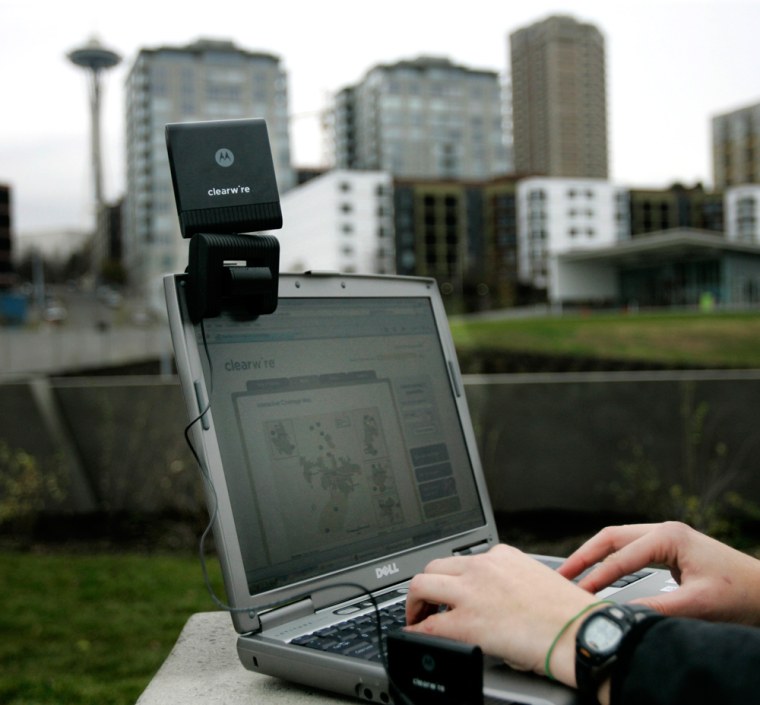My cell phone rang just as I pulled my car into a park along the Puget Sound. I needed to add something to a news story I had written a few hours earlier, but I really didn't want to give up my evening stroll.
Instead of driving back to the office or hunting for a Wi-Fi hotspot, I booted up my laptop, plugged in a PC card, connected to the Internet and updated my story — all from a bench near the water, with a dreamy view of snowcapped mountains.
Such a feat is no surprise to anyone with a wireless card from a cellular carrier, but I wasn't connected to the networks of Verizon Wireless, Sprint or AT&T. Instead, I used an early version of the relatively new technology WiMax, which is being offered in Seattle by Clearwire Corp.
What's exciting here is the availability of yet another pipe for accessing the Internet at home, in the office and on the go. It raises the possibility that it not only will be faster but also — in theory — cheaper than the competition.
The Clearwire card saved me in a pinch when I needed to file a story from across town. But in the end, it didn't quite live up to my hopes for an "everywhere" broadband wireless connection. Coverage is far from complete, and it's still too expensive.
The company says its "pre-WiMax" network I tested is four to five times faster than cell phone providers' 3G, or third-generation, networks, and cheaper to deploy. It's also testing true WiMax, which can deliver connections that promise to be even faster over wider areas, and plans to launch its first network in the middle of 2008.
Kirkland, Wash.-based Clearwire sells high-speed Internet access and Internet-based calling for homes and businesses in 46 U.S. markets, including Seattle, Syracuse, N.Y., and Duluth, Minn. It offers an array of plans, with varying discounts and contract commitments.
(Today, relatively few consumers have access to WiMax, but the technology will be offered by other companies and will likely find its way into a much broader range of devices in the future, thanks to the support of an industry group that includes big names like Intel Corp. and Samsung.)
Clearwire's PC card offering speeds of 1.5 megabits per second — similar to the promises of the phone company's basic home DSL connection — runs $59.99 (with free shipping and free activation). A fixed home modem is free for three months for the same speed but balloons to $36.99 a month for the rest of the two-year contract.
I tried out the $60 plan, which actually costs $67 when you add in the equipment lease and taxes. The company activated my account and sent me two boxes, one with the PC card (about the size of a Hershey bar) and software, and one with an antenna several times that size, to boost reception when needed.
The software installation was quick and painless. When I plugged the card into my laptop, a box popped up on my screen asking if I'd like to use Clearwire or my computer's internal Wi-Fi to connect to the Internet. After I clicked Clearwire, a new icon in my taskbar lit up with green dots. (One green dot is an "acceptable" connection, while four is the speediest.)
After that, I had no problems starting up the secure connection to my office network or doing any of the basic Web surfing, e-mail reading and instant messaging that makes up the bulk of my computer use.
Judging by the green dots and an unscientific sense of how fast Web pages loaded, the best places to use the PC card are wide-open outdoor spaces. On the freeway around downtown Seattle, I consistently got three or four dots, and downloaded YouTube videos while instant messaging and checking my e-mail, all with no hiccups.
But at my desk in the office, my living room at home and even on my front porch, I averaged one or two green dots. At home, Web surfing felt slower than my painfully weak Wi-Fi, even when the antenna was connected.
John Saw, Clearwire's chief technology officer, investigated. According to the company's coverage maps, my house isn't covered for PC card use because it's in a valley. I had no way of knowing this, though, because the Clearwire Web site indicated it would work in my zip code. Saw said my neighbors three blocks to the east would have fewer problems.
Saw added that the PC card is designed for people on the go, and suggested that if I want Internet access at home I should try Clearwire's regular stay-put modem, which has a stronger antenna and should work inside my house, based on the coverage map.
Nevertheless, I ran my laptop through a few simple tasks to compare the PC card's indoor performance with my office's wired Ethernet connection. A speed test on Speakeasy Inc.'s Web site clocked the office Ethernet connection at around 4,899 kilobits per second for downloads, and about 397 kbps for uploads.
Using the Clearwire card, my laptop downloaded data at a rate of about 386 kilobits per second, and uploaded at about 105 kbps.
For a real-world comparison, I downloaded episodes of the hour-long TV series "Dexter" from iTunes, while continuing to do other work. Over the Ethernet connection, it took just over 45 minutes to download a 630-megabyte episode; using the Clearwire card from the office conference room, it took two hours. Speeding along the interstate, iTunes estimated it would take about an hour and a half.
In the weeks I spent carrying the card around, it absolutely saved me twice. But when I'm at the park or enjoying a good view, I realized I don't actually want to be instant messaging. And for e-mail checks and other necessary online errands when I'm out on the town, my smart phone is quicker and more convenient.
